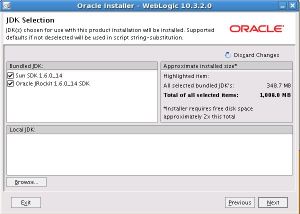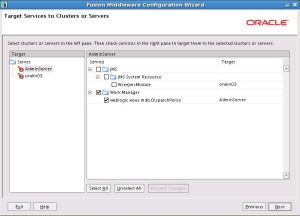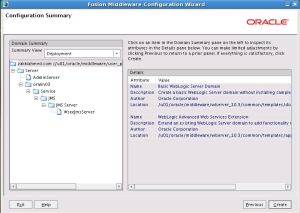Step by Step Installing And Configuring of WebLogic Server
Login as a root user and make sure the /etc/hosts file contains correct entries for both the “localhost” and real host names:
Following is the example of a host file
oracle@testdb lib]$ cat /etc/hosts
# Do not remove the following line, or various programs
# that require network functionality will fail.
127.0.0.1 localhost.localdomain localhost
172.16.0.2 testdb.pac.com.sa testdb
Create the directories in which the Oracle WebLogic software will be installed using following commands:
mkdir -p /u01/app/oracle/product/ofm12.1.2
mkdir -p /u01/app/oracle/config/domains
mkdir -p /u01/app/oracle/config/applications
chown -R oracle:oinstall /u01
chmod -R 775 /u01/
Create an operating user “oracle” to own the WebLogic Server, so as a “root” Super User do the following:
#groupadd dba
#useradd -g dba oracle
#mkdir -p /u01/oracle/middleware
#chown -Rh oracle:dba /u01/oracle/middleware
#xhost +
Now login as “oracle” and invoke the installer (I’ve downloaded the installer at /u01/dumps) as seen below. Click “Next”
Start the WebLogic Server
Login as a root user and make sure the /etc/hosts file contains correct entries for both the “localhost” and real host names:
Following is the example of a host file
oracle@testdb lib]$ cat /etc/hosts
# Do not remove the following line, or various programs
# that require network functionality will fail.
127.0.0.1 localhost.localdomain localhost
172.16.0.2 testdb.pac.com.sa testdb
Create the directories in which the Oracle WebLogic software will be installed using following commands:
mkdir -p /u01/app/oracle/product/ofm12.1.2
mkdir -p /u01/app/oracle/config/domains
mkdir -p /u01/app/oracle/config/applications
chown -R oracle:oinstall /u01
chmod -R 775 /u01/
Create an operating user “oracle” to own the WebLogic Server, so as a “root” Super User do the following:
#groupadd dba
#useradd -g dba oracle
#mkdir -p /u01/oracle/middleware
#chown -Rh oracle:dba /u01/oracle/middleware
#xhost +
Now login as “oracle” and invoke the installer (I’ve downloaded the installer at /u01/dumps) as seen below. Click “Next”
Enter the location for Middle Ware Home and click “Next”
Register for Security Updates if you wish to and click “Next”
Choose Install Type, I’ve chosen “Custom” and click “Next”
Choose “Products and Components” you wish to use and click “Next”
If you have previous JDK/JRockit SDK, you can choose to browse the path, although Oracle recommends that you download the latest JRockit SDK to use with WebLogic. You can download the latest JRockit from:
http://www.oracle.com/technology/products/jrockit/index.html
http://www.oracle.com/technology/products/jrockit/index.html
Choose “Product Installation Directories” and click “Next”
Review the Installation Summary and click “Next”
10. Once the installation completes, the “Run QuickStart” is checked. We’ll launch the QuickStart by clicking “Done”
Once clicked “Done”, You will be presented with the following which lets you choose 3 Options, We’ll go ahead with the 1st to proceed with the configuration wizard.
Configuration
Now in the configuration wizard, we’ll choose “Create New WebLogic Domain” and click “Next”
Choose the defaults, I’ve also chosen “WebLogic Advanced Web Services Extension” from the following screen, click “Next” to proceed
Now enter the Domain Name and Enter the Domain Location, click “Next” to proceed:
Configure the WebLogic Administrator and Password, click “Next” to proceed.
As this is a basic install and for development purposes, I will choose the “Domain Startup Mode” as “Development. Careful consideration should be taken for production deployment. Click “Next” to proceed
Select the Optional Configuration , I’ve selected the following options(we can configure JMS at a later stage):
Configure the Admin Server:
Configure the Managed servers and click “Next”
Next screen asks you if you wish to configure cluster, I did not configure any cluster. Click “Next” to proceed.
Next Screen is Configure Machines, I’ve not configured any. Click ” Next” to proceed
Configure Target Services to Clusters or Servers, review and click “Next” to proceed
Review the Configuration Summary and click “Create”
Click “Done” to finish and close the quickstart screen.
Now that we have installed and configured the WebLogic server, lets start the WebLogic server for the domain we configured. The startup scripts are placed in the user_projects directory for the domain we configured.
Start the WebLogic Server
[oracle@testdb]$ cd[oracle@testdb]$ cd /u01/oracle/middleware/user_projects/domains/newdomain[oracle@testdb]$ lsautodeploy init-info startWebLogic.shbin lib WseeFileStoreconfig security WseeFileStoreAdminServerconsole-ext serversfileRealm.properties startManagedWebLogic_readme.txt[oracle@testdb]$./startWebLogic.sh
Now that the WebLogic Server is started lets login to the console
In to order login to the console open the web browser , the URL will be of the following format:
http://<hostname>.<domain name>:7001/console
In my case it will be
You will be presented with the following screen:
The user name is “weblogic” and the password is what you configured during the configuration.
You will be presented with a neat front page, navigate to check the state of services on the left panel, follow the screenshot:
Thats all, the installation and basic configuration of WebLogic Server is complete.






















No comments:
Post a Comment